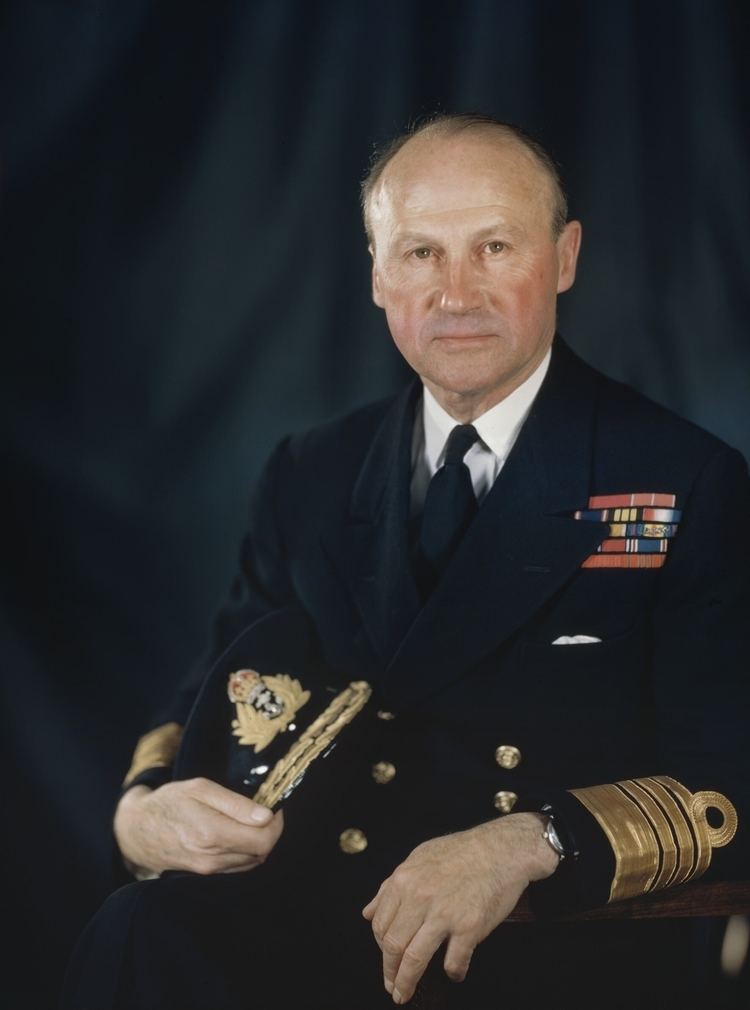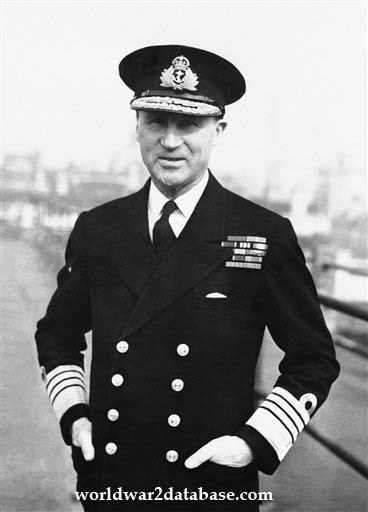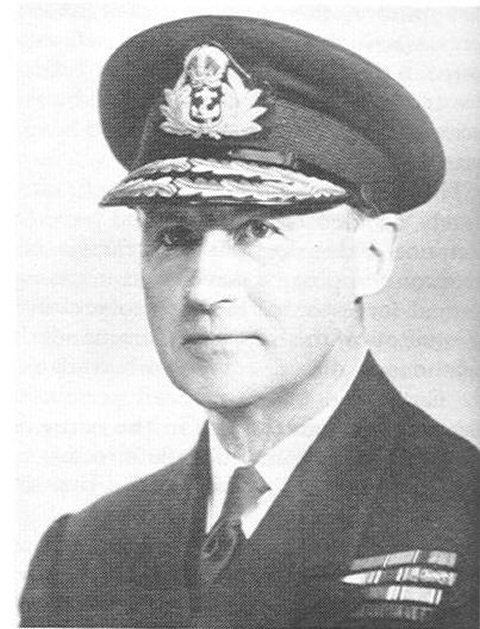Rank Admiral | Years of service 1898 - 1945 Name Bertram Ramsay Books The year of D-Day | |
 | ||
Battles/wars First World WarSecond Ostend RaidZeebrugge RaidSecond World WarOperation DynamoOperation TorchOperation HuskyOperation Neptune Awards Knight Commander of the Order of the BathKnight Commander of the Order of the British EmpireMember of the Royal Victorian OrderMention in Despatches (two)Legion d'honneur (France)Legion of Merit (United States)Order of Ushakov (USSR) Similar People Arthur Tedder - 1st Baron Te, Trafford Leigh‑Mallory, Omar Bradley, Bernard Montgomery - 1st Visco, Miles Dempsey | ||
Bertram Ramsay
Admiral Sir Bertram Home Ramsay KCB, KBE, MVO (20 January 1883 – 2 January 1945) was a British admiral during the Second World War. He was an important contributor in the field of amphibious warfare, and was responsible for the Dunkirk evacuation in 1940.
Contents
- Bertram Ramsay
- service for 75th anniversary of Dunkirk at the home of Admiral Sir Bertram Ramsay
- Personal life
- First World War
- Second World War
- Operation Dynamo
- Defending Dover
- Operation Torch
- Operation Husky
- Operation Neptune
- Death
- Awards
- Legacy
- Additional reading
- References
service for 75th anniversary of Dunkirk at the home of Admiral Sir Bertram Ramsay
Personal life

He was born in London, into an old family (see Ramsay Baronets). His parents were Brig.-Gen. William Alexander Ramsay and Susan Newcombe Minchener. He attended Colchester Royal Grammar School. In 1898, he joined the Royal Navy. Serving on HMS Britannia, he became a midshipman within a year. Following his promotion, he was transferred to HMS Crescent, and was confirmed in the rank of sub-lieutenant on 15 September 1902. He was promoted to lieutenant on 15 December 1904.

On 26 February 1929, he married Helen Margaret Menzies, daughter of Colonel Charles Thomson Menzies. They had two sons, David Francis Ramsay (born 1 Oct 1933), and Charles Alexander Ramsay (born 12 Oct 1936); Charles was educated at the Royal Military Academy Sandhurst and rose to become Director General of the Territorial Army.
First World War

During the First World War, Ramsay was given his first command, the "M 25", a small monitor, in August 1915. For two years his ship was part of the Dover Patrol off the Belgian coast. Promoted to commander on 30 June 1916, in October 1917 he took command of another Dover Patrol vessel, the destroyer HMS Broke.

On 9 May 1918, his ship took part in the Second Ostend Raid, a follow up to the Zeebrugge Raid, and he was mentioned in despatches.

Resigning from the Navy in 1938, he was coaxed out of retirement by Winston Churchill one year later to help deal with the Axis threat.
Second World War
Promoted to Vice-Admiral, he was placed in charge of the Dover area of operations on 24 August 1939. His duties included overseeing the defence against possible destroyer raids, the protection of cross-Channel military traffic and the denial of the passage through the Straits of Dover by submarines.
Operation Dynamo
As Vice-Admiral Dover, he was responsible for the Dunkirk evacuation, codenamed Operation Dynamo. Working from the underground tunnels beneath Dover Castle, he and his staff worked for nine days straight to rescue troops trapped in France by the German forces.
For his success in bringing home 338,226 British and allied soldiers from the beaches of Dunkirk, he was asked to personally report on the operation to King George VI and was made a Knight Commander of the Order of the Bath.
Defending Dover
After Operation Dynamo was completed, he was faced with the enormous problems of defending the waters off Dover from the expected German invasion. For nearly two years, he commanded forces striving to maintain control against the Germans, gaining a second Mention in Despatches.
Operation Torch
Ramsay was to be appointed the Naval Force Commander for the invasion of Europe on 29 April 1942, but the invasion was postponed and he was transferred to become deputy Naval commander of the Allied invasion of North Africa.
Under the Allied Naval Commander of the Expeditionary Force, Sir Andrew Cunningham, Ramsay planned the landing efforts.
Operation Husky
During the Allied invasion of Sicily (Operation Husky) in July 1943, he was Naval Commanding Officer, Eastern Task Force and prepared the amphibious landings.
Operation Neptune
He was re-instated to the Active List on 26 April 1944 and promoted to the rank of Admiral on 27 April 1944.
He defused a potential conflict between Prime Minister Winston Churchill, and the British Sovereign, King George VI, when Churchill informed the King that he intended to observe the D-Day landings from aboard HMS Belfast, a cruiser assigned to bombardment duties for the operation. The King, himself a seasoned sailor and a veteran of the battle of Jutland in the First World War likewise announced that he would accompany his Prime Minister. The two were at civil loggerheads until meeting with Admiral Ramsay who flatly refused to take the responsibility for the safety of either of these two luminaries. Ramsay cited the danger to both the King and the Prime Minister, the risks of the planned operational duties of HMS Belfast, and the fact that both the King and Churchill would be needed at home in case the landings went badly and immediate decisions were required. This settled the matter and both Winston Churchill and King George VI remained ashore on D-Day.
Although the men fighting on the beaches of Normandy on D-Day richly deserve the attention given to their efforts, the job of the naval forces was also of vital importance. In 1944, Ramsay was appointed Naval Commander-in-Chief of the Allied Naval Expeditionary Force for the invasion.
Death
On 2 January 1945, he was killed when his plane crashed on takeoff at Toussus-le-Noble, southwest of Paris. He was en-route to a conference with General Bernard Montgomery in Brussels. His body was buried in Saint-Germain-en-Laye New Communal Cemetery. A memorial to all who died in the crash was erected at Toussus-le-Noble in May 1995; photographs of the memorial can be seen here.
Awards
Legacy
A statue of Ramsay was erected in November 2000 at Dover Castle, close to where he had planned the Dunkirk evacuation. His involvement in it and the D-Day landings has led to several appearances as a character in film and television drama - in The Longest Day (1962, played by John Robinson), Churchill and the Generals (1979, played by Noel Johnson), Dunkirk (2004, played by Richard Bremmer) and Ike: Countdown to D-Day (2004, played by Kevin J. Wilson). His name was also recently added onto the Colchester Royal Grammar School war memorial, along with other Old Colcestrians who had been omitted. A portrait is also to be put up in the school. Admiral Ramsay's legacy has been remembered by the Royal Navy; they have used his name for the Apprenticeship Centre at HMS Collingwood in Fareham, the Ramsay Building which was opened by his son in March 2012.
